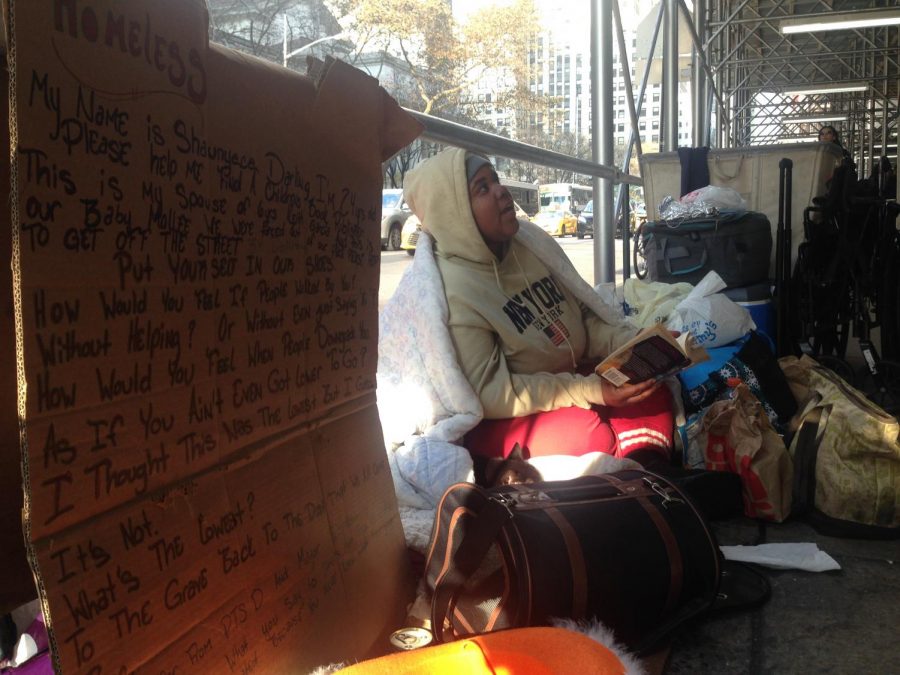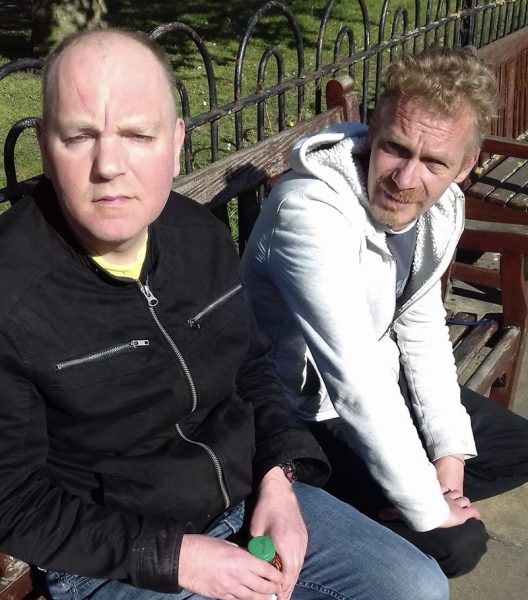Struggles Homeless Females Face in the New York Streets
Being a woman is a huge struggle in society. The biggest problem they are facing right now is being treated as sex objects, getting raped and sexually harassed, or assaulted by someone with more authority.
This all happens in an environment where they should feel safe but aren’t. For homeless females, those problems usually double. They don’t have a place where they can feel safe because they are living in the streets where people feel they can do whatever they want with them. They are looked down upon because of their statues of living.
Shaunyece Darling, a 24 year old that is currently living on the sidewalk of Madison Avenue and 41 street with her husband of six years, Keith Garcia and their black cat Mollee faced these harassments numerous of times during the two years that she’s been living in the streets.
She was nearly raped while sleeping next to her husband. They were both asleep in the night. She woke up with a cut pants and a man standing over her. She immediately jumped up and alerted her spouse who made the man run away. Her husband tried looking for him but had no luck.
“There is a difference between a torn and a cut. My jeans was cut in-between my legs,” says Darling.
Most of these homeless females face the same experience in the streets regardless of how they became homeless. They all have their own personal stories and have faced numerous sexual advances.
Darling and her husband were forced out of their apartment without any notice. They went to a homeless shelter to find a place to stay but were denied because they had a pet cat.
Most homeless shelter do not accept pets, which is the reason why there are some homeless people with their pets. For that reason, many people tend to live in the streets because they don’t want to abandon their friend and companion.
With nowhere to go and with no homeless shelters taking in animals, the couple made a choice. They would rather sleep on the streets than get rid of their baby, Mollee.
Darling trained Mollee to not leave her side. It is very rare to see a cat by a homeless person side, since they tend to stray off to another place. Darling explained that she once had two cats but one of them was stolen from her as she lived in the streets.
Darling suffers from post traumatic stress disorder also known as PTSD and major depression. PTSD is a type of disorder that develops after individuals experience a shocking, scary, or dangerous event, according to National Institute of Mental Illness.
Molle helps Darling get through her mental illness which is one of the reasons why she prefers to live in the streets than leave her cat behind.
Darling, Mollie, and Keith sleep on a couple of comforters roughly placed on the sidewalk surrounded by boxes filled with books, food, suitcases, plastic bags, a cooler, a wheelchair, a sign explaining why they are homeless and asking for donations. Also, a bright orange fluffy cowboy hat for individuals to place donations.
Part of the sign titled Homeless says “Put yourself in our shoes. How would you feel if people walked by you? Without helping? Or without even saying hi?”
The sidewalk is their mini apartment with the world getting a glimpse of everything that they own and capturing their every move. The sounds of the cars are very loud and chaotic. Hearing and seeing thousands of footsteps everyday. This has all become very normal to them.
When it’s extra cold, the painful type of cold that numbs the body, they move to the train stations and inside the trains where they find shelter and warmth.
They tried to stay in a cheap hotel or motel on the very cold nights but they decided not to that again. It is too expensive for them and they need to save money so when they get off the streets they have some money to survive.
Darling and her husband get food stamps from the governments as well as extra cash. They also get donations and food from people. This is how they are able to somewhat survive on the streets.
The two worst experiences for Darling since being on the street is being almost raped and having other homeless individuals steal her belongings and food. She is also given “old” and “ eaten” food.
A research report retrieved from the U.S. Department of Justice says that homeless female are at a higher risk of being sexually assaulted. It mentioned that 78.3 percent of homeless women in the study had been subjected to rape, physical assault, and/or stalking at some point in their lifetime. Only 9% of the women report the assault.
Homeless females have it worse than male because of their sex, says Professor. Kelly. Other homeless people take advantage of them because they are by themselves and have no one to protect them. Women don’t know where is safe, they feel that they have reached the bottom with no solution or no one to turn to.
“Males want to dominate woman. With sex, they bring them down,” Kelly explains.
It’s hard to get out of men’s minds that they are superior because that’s what they have been taught and it’s hard to break a tradition. Men take the idea of being the “macho man” and they feel that they can do whatever they want with a female because they are tougher than them which shouldn’t be the case but is, says Kelly.
Darling tried to file a police report about it. She called the police and told them about the possible rape she faced but they didn’t show up.
“Some of them don’t care,” said Darling
Darling can’t say that all the police officers don’t care about the people in the streets because she has encountered a few who have help her in times of trouble.
“They are humans. There are some humans that are nice and some are not. Some people are judgemental and some people are not. The officers that are not judgemental are the ones that would go out and ask questions. The officers that think that every person that is homeless is on drugs and alcohol, they are the ones that will be judgemental,” said Darling.
If a police officer or an individual tries to bother her or if she is being removed from a public space, she calls their boss to report them.
She has a phone for emergencies and tries to keep it charged. She has the police sergeant number who is around the area on speed dial, one that she met through her case worker.
“My uncle is also a police officer and knows other police officers and FBI agents in every part of New York. If the Sergeant doesn’t pick up, I can also call him,” said Darling.
Homeless isn’t a crime, so officers can not remove someone from the street unless they are doing something illegal or disturbing the peace. They can be cited for encroachment which means that a person has their belongings in a sidewalk, alley or other public property, making it hard for people passing by to walk. They are asked to move, if they are right next to a store or business then they need to move away from it because they are invading the property of someone but they can be on the sidewalk.
There is a law that states that if there isn’t a sign that says that a person shouldn’t trespass then they are allowed to be there. As well if the person enters a private property without honestly knowing that the land was private. In that case, homeless people can be in any street if and only they don’t block the sidewalk with their belongings, invade someone’s property and aren’t disrupting the streets and people.
Anyone who has been in the city of New York will tell you that in every block or train station, they have encountered a homeless person begging for money.
Some pass them by without acknowledging them,while others put in a few spare change in their cup. Whether you chip in money or not, you must have questioned yourself why or how did this person get placed in a position where they have to beg for money and live off scraps.
Every homeless person has a different story of how they ended up living in the streets. Some people may assume that they are drug addicts or alcoholics trying to take money from the people to buy those supplies and ended up in the streets because they couldn’t afford the money to purchase these thing. Some may judge them for being young and still capable of finding a job but are lazy to do so. Others think that they are a crazy individual who was not wanted in their family and so ended up alone in the streets. However, these reasons are not always the case.
Prof. Kelly, a Sociology professor from Mercy College, explains the reason why some people won’t help or even acknowledge the homeless.
“People see them and say it’s there own fault, they expect the system to support them, that those people are lazy and want handouts. Maybe that they are drug addicts or crazy and have adjusted to being in a particular place. They don’t feel like they belong. They feel unwanted or looked down upon.” explains Kelly.
Life on the street is even worse than what meets the eyes. There are people giving homeless people food that is already bitten or eaten from or even worst– food from the trash. They are homeless but they are humans, experts say.
People touch and steal their stuff all the time. Darling has had extra clothes but they were stolen from her. She only carries a few clothings that she has managed to keep with her at all time, she carries a laundry bin with her at all times. She also washes up and brushes her teeth in public bathrooms.
“I wish I can soak in a tub, that would be nice,” said Darling smiled visualizing it.
Darling has aspirations in life. From being a fashion designer, to a lawyer, teacher, an entrepreneur, and homeless shelter owner, Darling has already set her goals for the future.
She reads a lot, have detailed sketches of clothes designs she drew, a draft of a children’s book, and is currently working on her life memoir. She wants to find a publisher to help her publish her stories. She hopes to go to college in the future and work with fashion designers in future to make her sketches become reality.
“We know most of the homeless people by names,” said a police officer on duty in Grand Central Station.
Police officers only arrest homeless who are break the law or have a misconduct. They can’t arrest people for just being a specific place. Officers can ask them to move if they are misbehaving or blocking people from passing. They can’t kick the homeless out, unless they did something bad or hurt another individual.
“Homeless population has definitely grown. They have given up on themselves and only see a negative self image. A lot of them die because they don’t take care of themselves.” says Kelly.
Bernice Thomas also known as Miss B., an older lady who was homeless for sixteen years shares her experiences and her viewpoints of the street and homeless shelters.
“I’ve been out here so long. Everybody knows me.”
Thomas is a very energetic 71-year-old social lady that has lived life between homeless shelters, the street, and people apartments.
She is sick and has congestive heart failure, asthma and had brain surgery. That’s just a few on the list.
Congestive heart failure occurs when the heart is weak which leads to buildup of fluids in the lungs and around the body tissues.
“Everybody is all about money. It’s not about making money. I am more about conversation. You can’t judge a person and expect them to give you money,” said Thomas.
Being in the streets give homeless people a sense of freedom that they don’t have in shelters. They feel safer in the streets than in the shelter because the shelter sometimes fails them and hurt them instead of helping them, Kelly explained.
“They don’t want to be conformed. They have freedom in the streets but there are dangers like being abused and raped,” continues Kelly.
She is no longer homeless and last year got her own studio with the help of some individuals. It consists of just a room and bathroom. A case manager from the hospital contacted a director of a program and he put her on top of the list because she needed homecare. They rented her a room after a few months.
She still spends her free time on the street, when she isn’t feeling too sick.
“I sit here all day and flirt, cuss, scream. They think I am this crazy lady. That’s just my way of distracting people,” said Thomas.
She stays in the street in order to collect money not for her but for other people. She doesn’t have much but still gives a lot. She give donations she get from others, she feed other homeless people with food that is provided to her, and gives clean clothes and necessities.
She takes all the food people give her, never declines. She has a bag of food and at the end of the day she gives it away to those that need it.
“I do what I can to help others out here. That’s what I do,” said Miss B.
Thomas speaks on her distaste of the homeless shelter.
“It’s nasty. It’s abusive. I got marks on my body to prove it,” shares Miss B.
There are about 750 homeless shelters in the New York area, most are filled with men.
Most homeless people decide to live in the streets than go to a homeless shelter because of the male and female ratio.
Miss B. shares that there was a lot of prostitution in the shelter that she lived in. In a survey pulled out from Clearinghouse Review: Journal of Poverty Law and Policy, said that over 13% of the respondents reported having worked in prostitution and 22.4 percent had been forced into prostitution.
Miss B. went to the Tillary Street Women’s Shelter in Brooklyn, New York from time to time.
The shelter was founded in 1986 by Peter C.Campanelli. They provide beds and services for the adults who are mentally ill. Over the years they welcomed homeless adults with mental illness or addiction disorder. They welcomed mothers with mental illness who were separated by their children. They have health clinics that provide medical, dental and phycology care for their residents. Currently, they have over 1,000 people who are veterans, families and children, homeless, mentally ill and disabled.
Someone allegedly slammed Miss B’s hand in the door during the time she was in that shelter, which lead her to get seven stitches on her one finger. She said that no one never did anything, even though it was reported. A next incident was when she broke her foot and they didn’t do anything either.
“They never did anything, they don’t do anything. They lie,” siad Thomas.
She said she had clothes in the shelter and they threw it away. Her list of stories about the homeless shelter is very long. She only had negative comments when talking about the shelters. She would not suggest a homeless person to go to a shelter because she thinks it would be safer to be in the streets than in the shelters where there is prostitution.
“When you are in the shelter, all you’re exposed to is prostitution and drugs. Woman sleeping with woman. Man sleeping with woman. People are in and out all night selling their bodies,” said Miss B.
The shelter was called to confirm or deny the allegations but all they said was that they “weren’t allowed to say anything.” They gave a number that led to a courthouse which had zero information about the shelter.
Thomas sometimes only make three dollars from donations a day. She has a small brown card box sign that says she needs help. Miss B. has made a family on the street.
“People who I interact with me treat me like their grandmother. They bring me their children to visit me. Buy me things I need.” explains Miss B.
These two women, Thomas and Darling, represent two different age groups but they share some similarities in their types of experiences. They both have it hard and have to deal with situations people overlook. They are just two of many women who have been a victim of sexual assault. They are talking on their experience to bring awareness of what happens in homeless shelters and on the street. There are many more in the streets who feel trapped and unwilling to speak about it.
In order to help females who are homeless, we must take steps to help them, Kelly explains. The struggles that female have to endure in the streets can be preventable, if we all help each other and talk to them to try to understand the issues that they are going through.
“Society needs to change and figure out that it is their responsibility as people is to take care of the homeless, especially the females who are in much danger in the streets.”

The name is Loaiza, Andrea Loaiza. She is currently a junior in Mercy College on her way to getting her bachelors in Media and Journalism. She...

Tanisha Esprit, also known as Tan Tan or T, is majoring in journalism at Mercy College. She is from the breathtaking island of St.Thomas, USVI. She enjoys...








